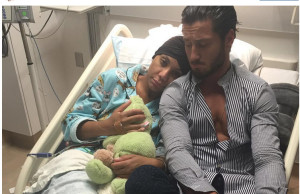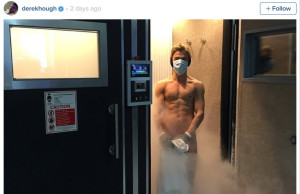Joey McIntyre talks about his newborn’s hearing problems

New Kids on the Block singer (as well as former Dancing with the Stars contestant) Joey McIntyre spoke to People magazine about his 3-month-old son Rhys’ s hearing problem. Little Rhys, after failing his newborn hearing screening test, was extensively worked-up and determined to have severe hearing loss. Although McIntyre and his wife Barrett were shocked by the diagnosis, they did not simply throw up their hands: Joey told People : “We’re being totally proactive about the situation. That meant signing up for speech therapy and getting Rhys fitted for hearing aids in both ears when he was just a month old.” The McIntyres are now seeing things in a positive light- Rhys responds to their voice and is doing all the age-appropriate developmental things. Barrett says: “He’s really easy-going; he has that chill vibe. Rhys’ hearing loss won’t stop him from doing anything.”
According to the National Institutes of Health:
“Two to three of every 1,000 children in the United States are born deaf or hard-of-hearing, and more lose their hearing later during childhood. NIH-supported research suggests that the most intensive period of speech and language development is during the first three years of life — a period when a child’s brain is developing and maturing. If a child is not exposed to language during this period due to hearing loss, he or she will have more difficulty developing spoken or signed language, and reading skills. In addition, during the early stages of life, the brain builds the nerve pathways necessary for understanding auditory information. For these reasons, identifying hearing loss as early as possible, by the time a child reaches three months of age, enables pursuing treatment options early so that a child can learn to communicate comparably with his or her hearing peers.”
What is Universal Newborn Hearing Screening?
Most babies have a hearing screening soon after birth, usually before they leave the hospital. This is often called Universal Newborn Hearing Screening (UNHS). That means everybody is screened. UNHS is the first step in the Early Hearing Detection and Intervention (EHDI) programs. Thirty-nine states plus the District of Columbia and Puerto Rico have mandated newborn hearing screening programs. An additional 5 states have voluntary programs. Most of the screening is done in the hospital, being the newborn is discharged for home. The procedure takes less than 10 minutes and is completely painless.
How does the inner ear work?
The inner ear is made of of two parts:the semicircular canals, which are important for balance, and the cochlea, a snail shell shaped organ which is responsible for hearing sounds. The cochlea is filled with a watery liquid, which moves in response to the vibrations coming from the middle ear via the oval window. As the fluid moves, thousands of “hair cells” are set in motion, and convert that motion to electrical signals that are communicated via neurotransmitters to many thousands of nerve cells.
There are two kinds of screening tests that can be done:
1. Otoacoustic Emissions (OAE): This test measures sound waves (like an echo) produced by the cochlea in response to sound. A tiny probe is put inside the opening of the ear canal which measures the echo which occurs when small clicks or tones are played in the baby’s ear. If cochlear hearing loss exists, the cochlea either will not generate a response or the response will fall below the level that is expected from an ear with normal hearing.
2. Auditory Brainstem Response (ABR): This test measures the auditory nerve’s response to sound. Small clicks or tones are, once again, played in the baby’s ear. This time, small surface electrodes are place at three places on the baby’s head. These sensitive devices are able to measure the small electric current which is the nerve’s response to the sounds.
What happens if my baby fails the screening test?
First of all, don’t panic! Screening tests are just that- screens for the possibility of hearing problems. Factors such as fluid in the middle ear, hearing loss at some but not all frequencies, and other factors can give false results. Formal hearing tests by a trained audiologist will need to be done to confirm whether hearing loss actually exists.
If the hearing loss is permanent, referrals for hearing aids and speech and language services will be offered.
The Individuals with Disabilities Education Act (IDEA) requires that free early intervention programs be offered to babies and children with hearing loss, beginning at the time the child’s hearing loss is identified.
According to the American Academy of Pediatrics, “The outlook is good for children with hearing loss who begin an early intervention program before the age of 6 months. Research shows these children usually develop language skills on a par with those of their hearing peers.”
For more information:
| Resounding Health(tm) Newborn Hearing Screening |





























0 comments